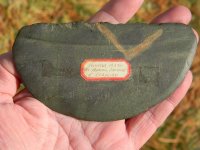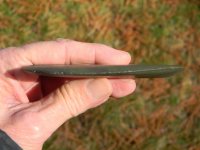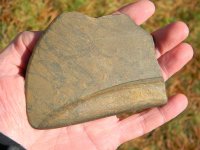I found this along a lakeshore in Southern New Brunswick while canoeing last summer. The closest thing I can find to compare to it are ground slate semi-lunar ulu knives, but the blade of what I've found is nearly flat.
The geometry reminds me of a chisel or single bevel broad axe.
It looks like the blade was pressure flaked along the entire edge on the beveled surface, while the back is nearly entirely flat. The upper surface is rounded and smoothed. Two of the corners have old breaks as you can see in the pictures. What on earth is it?





There are more pictures in the album here: https://imgur.com/a/NkoDT9p
The geometry reminds me of a chisel or single bevel broad axe.
It looks like the blade was pressure flaked along the entire edge on the beveled surface, while the back is nearly entirely flat. The upper surface is rounded and smoothed. Two of the corners have old breaks as you can see in the pictures. What on earth is it?





There are more pictures in the album here: https://imgur.com/a/NkoDT9p
Upvote
0





















